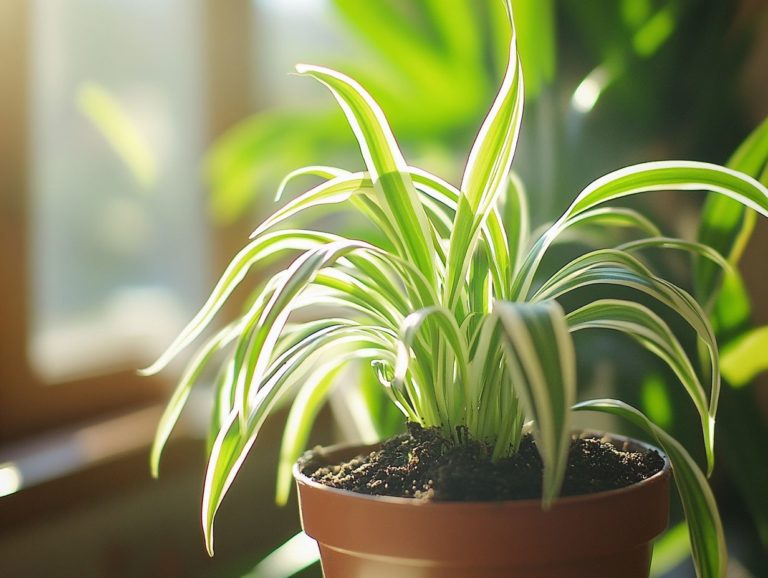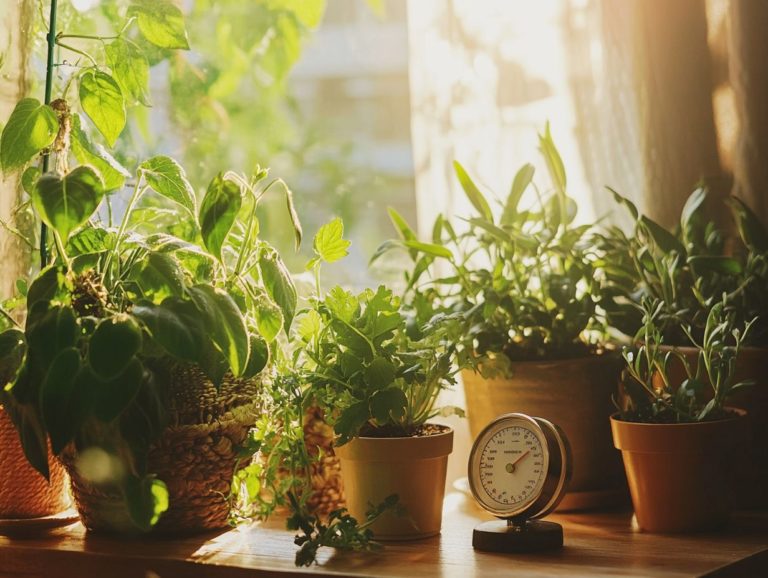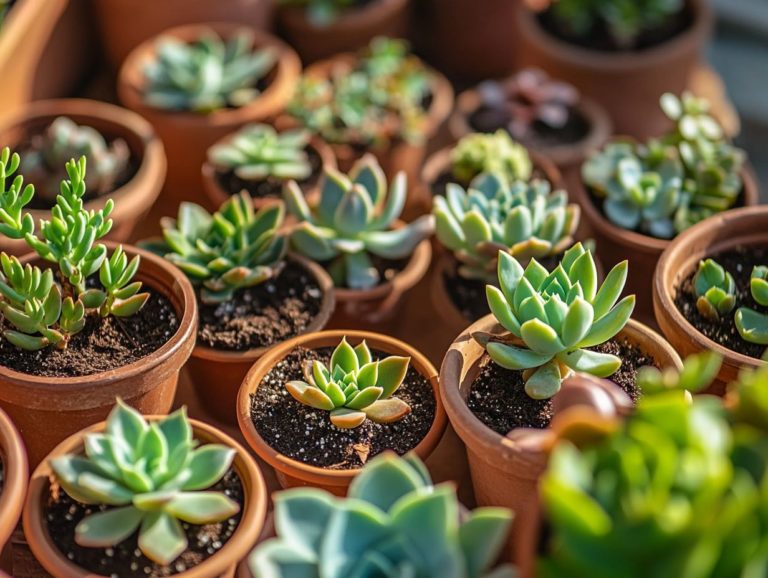How to Propagate Fiddle Leaf Fig Trees
If you’re a fan of the fiddle leaf fig tree, you appreciate just how striking and cherished these plants can be. Whether you’re looking to expand your collection or share your leafy companion with others, mastering the art of propagation is essential.
Get excited as you learn the best times to propagate and watch your green friends thrive! This article delves into various methods, including leaf cuttings, air layering, and seed propagation.
You’ll discover the optimal times for propagation and the secrets to ensuring your efforts flourish. Get ready to nurture new growth and elevate your plant care to new heights!
Contents
- Key Takeaways:
- What is Propagation?
- Methods of Propagating Fiddle Leaf Fig Trees
- When to Propagate Fiddle Leaf Fig Trees
- Tips for Successful Propagation
- Frequently Asked Questions
- What is the best time of year to propagate a fiddle leaf fig tree?
- How do I know if my cutting is growing roots?
- What materials do I need to propagate a fiddle leaf fig tree?
- Can I propagate a fiddle leaf fig tree in water?
- Can I propagate a fiddle leaf fig tree from a leaf?
- How long does it take for a fiddle leaf fig cutting to root?
- What should I do if my fiddle leaf fig cutting is not rooting?
Key Takeaways:
- Propagation is the process of creating new fiddle leaf fig trees from existing ones.
- Leaf cutting, air layering, and seed propagation are common methods for propagating fiddle leaf fig trees.
- The best time to propagate fiddle leaf fig trees is during the spring and summer months when the tree is actively growing. Signs that it is ready to propagate include healthy growth and root development.
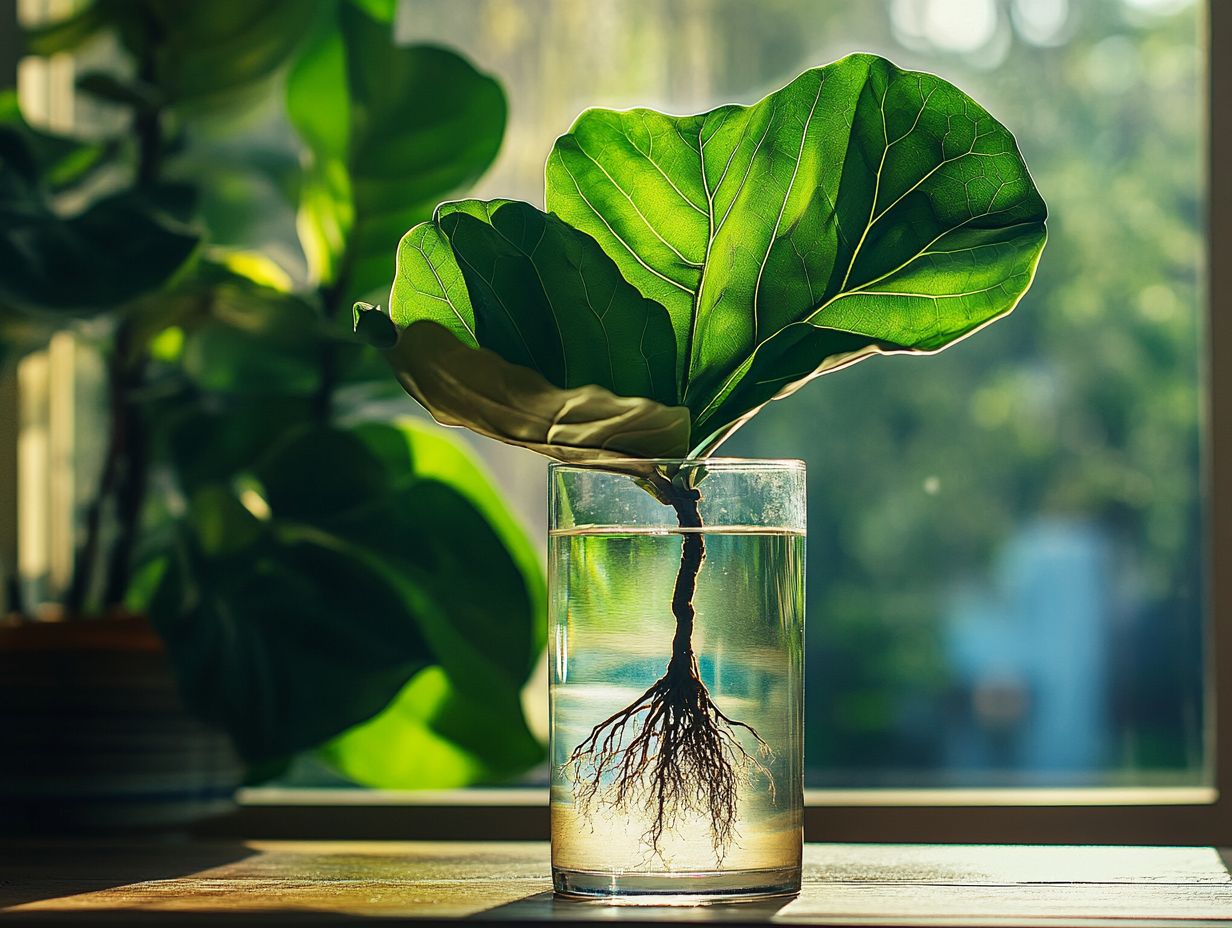
What is Propagation?
Propagation is the art of growing new plants from those you already cherish, enabling you to expand your collection, especially with sought-after varieties like the fiddle leaf fig (Ficus lyrata). This technique not only fosters sustainability but also encourages the delightful exchange of plants among friends and family.
Whether you choose to employ stem cuttings, leaf cuttings, or more sophisticated methods such as air layering, mastering propagation can significantly elevate your gardening skills and deepen your understanding of plant care.
Methods of Propagating Fiddle Leaf Fig Trees
You have a variety of effective methods at your disposal for propagating fiddle leaf fig trees, each offering distinct advantages. This allows you to select the best approach tailored to your circumstances and level of experience.
Common techniques include:
- Leaf cutting
- Air layering
- Seed propagation
Each method is carefully designed to stimulate the growth of new roots and promote healthy plants. For detailed guidance, check out how to propagate Peperomia plants. Choosing the right propagation method is essential for ensuring your plant care efforts flourish.
Leaf Cutting
Leaf cutting is a favored method for propagating fiddle leaf fig trees, enabling you to harness the plant’s natural growth potential through specific cutting techniques. This process begins with selecting healthy leaves and applying rooting hormone a substance that helps encourage new roots to grow to enhance the chances of developing new roots. Care during this stage is crucial for ensuring vigorous growth.
To kick things off, you ll want to carefully choose healthy, mature leaves from a well-established plant, making sure they are free from pests or disease. Once you have your ideal cuttings, apply rooting hormone to the cut edges to encourage rapid root development. Next, place your cuttings in a well-draining medium, ensuring they receive adequate moisture without the risk of overwatering, as too much dampness can lead to rot.
You can also create a warm and humid environment to support rooting. Covering your cuttings with a plastic bag or using a propagation dome can help create the perfect atmosphere. By regularly monitoring the conditions, you’ll get to witness the fascinating transformation of a simple leaf into a thriving fiddle leaf fig tree. Additionally, if you’re interested in expanding your indoor garden, check out this guide on how to propagate indoor ferns.
Air Layering
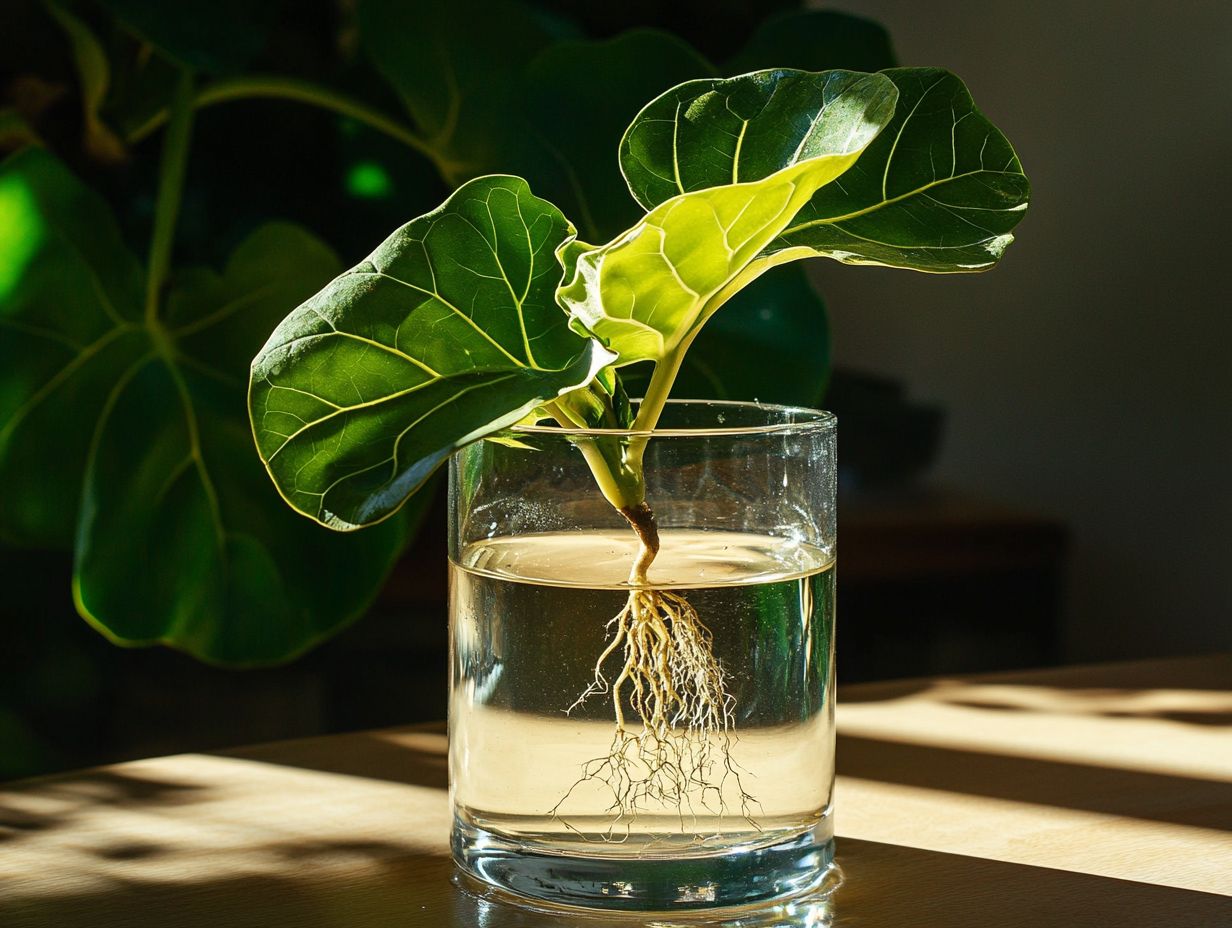
Air layering is an advanced propagation technique that enables you to create new fiddle leaf fig trees directly from the parent plant. It s a unique method that allows you to produce healthy specimens with strong new roots. This process requires careful attention to the part of the stem where leaves grow and involves wrapping a section of the stem with moist sphagnum moss and plastic wrap to encourage root formation.
To successfully execute this technique, gather essential materials, including:
- sharp knife
- sphagnum moss
- plastic wrap
- twist ties
Start by making a clean cut around the stem, just above a leaf node, to expose the layer just under the bark. Next, generously apply sphagnum moss to the open wound and wrap it tightly with plastic, ensuring it retains moisture. This creates a humid environment, which is essential for root development.
Stay on top of checking the moss to ensure it stays damp. Exercise patience as roots form over several weeks. Once you see roots, you can separate the new fiddle leaf fig and pot it, marking the end of a rewarding propagation journey. For those interested in how to propagate rubber plants, this process is quite similar.
Seed Propagation
Seed propagation is a lesser-known yet captivating method for cultivating fiddle leaf figs. It involves collecting seeds and nurturing them in a carefully selected soil mix to encourage germination and growth. While it demands patience and a grasp of best practices, the reward is immense for dedicated gardeners eager to witness the entire lifecycle of their plants from seed to maturity.
To embark on this seed propagation journey, you first need to identify mature fiddle leaf figs that produce viable seeds. Once gathered, soak the seeds in water briefly to boost germination rates. The right soil mix, rich in organic matter and with excellent drainage, is crucial for fostering healthy root development. If you’re interested in more propagation techniques, check out this guide on how to propagate Monstera plants.
Creating ideal conditions such as ensuring adequate moisture and warmth is essential. Patience is your greatest ally in this task. Each seed may have its own timeline for germination, so recognizing this will help you navigate this cultivation method with greater ease.
When to Propagate Fiddle Leaf Fig Trees
Understanding the optimal timing for propagating fiddle leaf fig trees can greatly enhance your success rate. These plants flourish during specific seasons. Typically, spring and summer are regarded as the prime times for propagation, when the plant is in its active growth phase and is more capable of adapting to new roots and environmental shifts.
It s crucial to recognize the signs that indicate your tree is ready for propagation. This awareness is key to achieving successful results.
Best Time of Year
The ideal time for you to propagate fiddle leaf fig trees is during the spring and summer months. The warmer temperatures and increased sunlight create a thriving environment for vigorous growth and robust root development. This is when your new cuttings or seedlings have the best chance to flourish, setting you up for a successful propagation experience.
As temperatures consistently range between 65 F and 85 F, you’re working in optimal conditions for root formation. These seasons also provide longer daylight hours, ensuring your plants receive the ample light necessary for photosynthesis and growth.
Higher humidity levels during this time further support hydration for your cuttings, making it easier for them to thrive. By using well-draining soil mixtures, you can enhance moisture retention, creating an ideal setting for your fiddle leaf fig to flourish. For those interested in how to propagate ZZ plants, all of these factors combined significantly boost your chances of successful propagation.
Signs that Your Tree is Ready to Propagate

Identifying the signs that your fiddle leaf fig tree is ready for propagation can significantly boost your chances of success. Keep an eye out for healthy growing points and the absence of damaged or unhealthy leaves, as these indicators signal a plant in prime condition for propagation. Check these conditions often to catch the perfect moment for your new cuttings.
It’s crucial to pay attention to the condition of the leaves. Healthy leaves should be vibrant and firm, free from brown spots or wilting, which could signal underlying issues. Look for signs of new growth emerging from the stems; this is a reliable sign that your tree is ready to be propagated.
Regularly checking for these conditions will ensure that your existing plant stays vibrant, resulting in a beautiful and flourishing fiddle leaf fig.
Tips for Successful Propagation
To ensure the successful propagation of your fiddle leaf fig trees, it’s essential to implement proper care and maintenance practices. Being mindful of common mistakes that can hinder your progress is equally important.
This involves providing adequate light, selecting a suitable soil mix, and routinely monitoring moisture levels. These steps will promote healthy root development and foster strong growth in your beloved plants.
Proper Care and Maintenance
Proper care and maintenance are essential for the successful propagation of fiddle leaf figs. These plants thrive in bright, indirect light and well-draining soil mixes. By ensuring the right conditions, you facilitate root development and promote overall plant health as your new specimens grow.
To achieve optimal light exposure, place your cuttings near a window where they can bask in filtered sunlight; direct sunlight can scorch those delicate leaves. Your soil mix should ideally consist of equal parts potting soil, perlite, and orchid bark. This blend creates a balanced medium that retains moisture while allowing for proper airflow.
In terms of watering, establish a routine that lets the top inch of soil dry out between waterings. This prevents the risk of overwatering, which could lead to root rot. By following these essential practices and learning how to propagate your favorite houseplants, you significantly boost your chances of nurturing strong, healthy fiddle leaf figs.
Common Mistakes to Avoid
Avoiding common mistakes while propagating fiddle leaf figs can dramatically enhance your success rate. Pay close attention to pitfalls like putting cuttings in water without proper preparation or neglecting to use the right pruning shears. Recognizing and addressing these errors will elevate your overall plant care experience.
Many propagators often underestimate the significance of humidity and bright indirect light, which are essential for nurturing healthy roots. Insufficient lighting can slow growth or even lead to decline, while excessively dry air can stifle root development. For those interested in growing these plants, understanding how to propagate Sansevieria plants can make a significant difference.
To tackle these challenges, consider creating a controlled environment that mimics the plant’s native habitat for optimal propagation results. Using a humidity dome or establishing a misting routine can provide the moisture your cuttings need, while placing them in bright, indirect light ensures they thrive during their transitional phase, facilitating the growth of new roots.
By addressing these common oversights, you can embark on a successful and rewarding fiddle leaf fig propagation journey.
Frequently Asked Questions
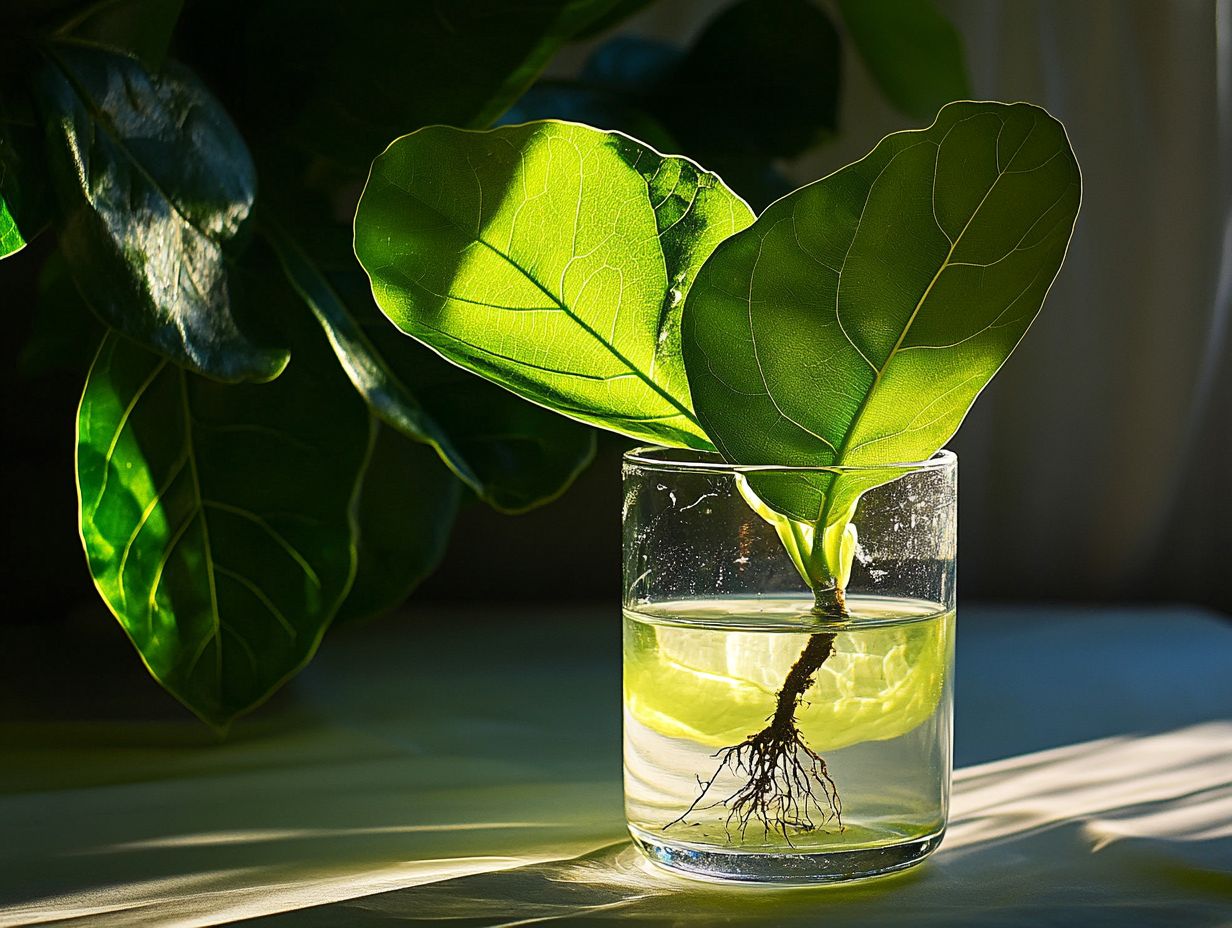
What is the best time of year to propagate a fiddle leaf fig tree?
The best time to propagate a fiddle leaf fig tree is during its active growing season, which typically falls between late spring and early summer. This will give the cutting the best chance for success as the plant is in its prime growing state.
How do I know if my cutting is growing roots?
Look for small, white roots emerging from the base of your cutting. This shows that your propagation efforts are successful!
Ready to try propagating your fiddle leaf fig? Start today and share your journey with us!
What materials do I need to propagate a fiddle leaf fig tree?
You will need a sharp, clean pair of pruning shears, a container filled with water, and a pot filled with well-draining potting mix. Optional materials include rooting hormone and plastic wrap to create a mini greenhouse for the cutting.
Can I propagate a fiddle leaf fig tree in water?
Yes, you can propagate fiddle leaf fig trees in water. Simply take a cutting from a healthy plant and place it in a container filled with water.
Change the water every few days. Keep the cutting in a bright spot with indirect light.
Can I propagate a fiddle leaf fig tree from a leaf?
No, you cannot propagate fiddle leaf fig trees from just a leaf. The cutting must have a small portion of the stem attached to root successfully.
How long does it take for a fiddle leaf fig cutting to root?
Typically, it takes 4-6 weeks for a fiddle leaf fig cutting to root. This time can vary based on light, temperature, and humidity.
Be patient; your green friend is on its way to thriving!
What should I do if my fiddle leaf fig cutting is not rooting?
If your cutting is not rooting after 6-8 weeks, it may not have enough nodes (small bumps on the stem) or the right conditions. Try taking another cutting and starting again.
Ensure your cutting is not exposed to direct sunlight. Also, check that the water or soil is not too wet or dry.


